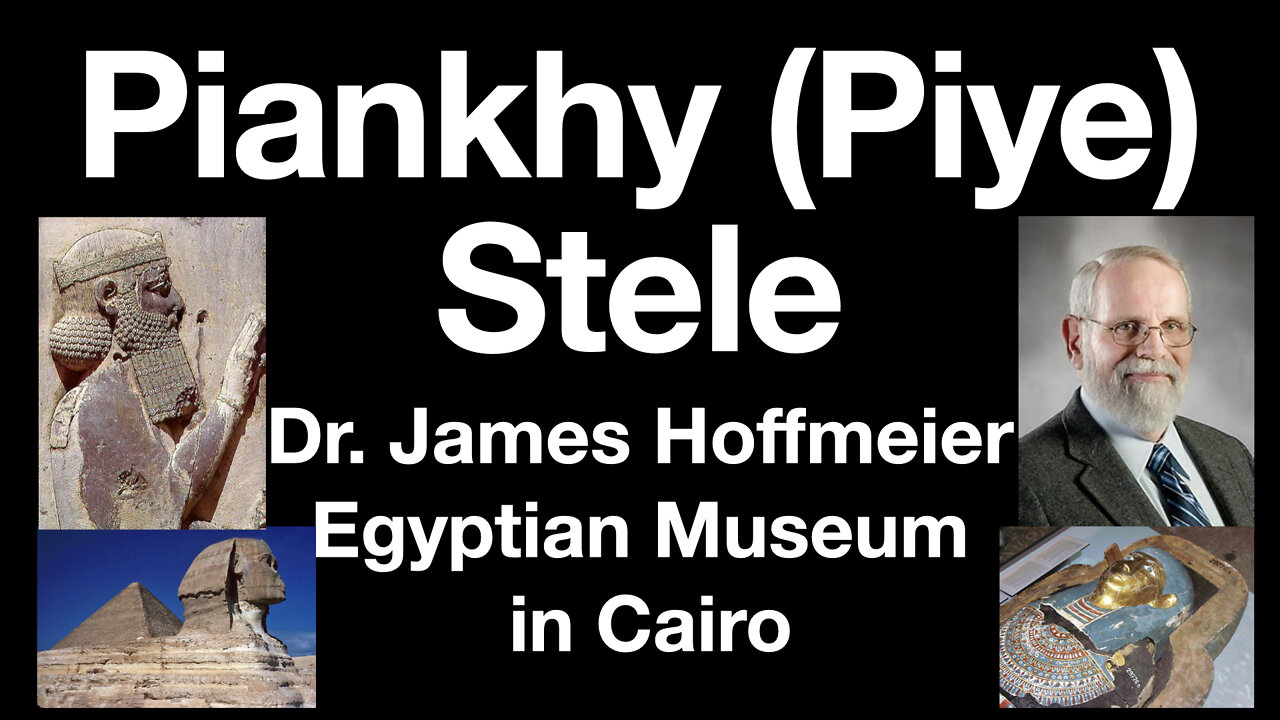Premium Only Content

Piankhy (Piye) Victory Stele & Isaiah 18, Cairo Museum: Egyptologist & OT scholar James Hoffmeier
The Piankhy (Piye) Victory Stele or Stela narrates Nubian King Piankhy’s victory over both Upper and Lower Egypt. It is the foremost historical inscription of the Egyptian Late Period. The Piankhy Victory Stela is commented upon by leading evangelical Egyptologist and Old Testament scholar James Hoffmeier, on site at the Museum of Egyptian Antiquities in Cairo, Egypt, where the stela is currently located.
Dr. James Hoffmeier (Ph. D., University of Toronto; M. A., University of Toronto; B. A., Wheaton College) is Professor Emeritus of Old Testament and Near Eastern Archaeology at Trinity International University, the Director of the North Sinai Archaeological Project, and a Consultant with appearances on the Discovery Channel, Learning Channel, History Channel, National Geographic, and other similar sources. He has written many scholarly books, including:
Ancient Israel in Sinai: The Evidence for the Authenticity of the Wilderness Tradition. Oxford: Oxford University Press, 2005.
Israel in Egypt: The Evidence for the Authenticity of the Exodus Tradition. Oxford: Oxford University Press, 1997.
The Piankhy Victory stele was composed around 725 B. C. and discovered in A. D. 1862 by George Reisner in the temple of Amun at Napata, the Nubian capital, at the foot of Gebel Barkal. It is 1.8 x 1.84 meters and 0.43 m thick, inscribed on all four sides with a total of one hundred and fifty-nine lines.
Some modern scholars have concluded that the king whose name was traditionally read as “Piankhy” was really “Pi” or “Piye.” It is possible that the Nubian form was “Pi” or “Piye” while the Egyptians understood it as “Piankhy,” resulting in some scholars now writing it as “Pi(ankhy).”
For a translation of the Piankhy / Piye Stele, see William W. Hallo & K. Lawson Younger, Context of Scripture (Leiden: Brill, 2000), 42–53.
The Piankhy Victory Stele Validates Isaiah 18:
Woe to the land shadowing with wings, which is beyond the rivers of Ethiopia: That sendeth ambassadors by the sea, even in vessels of bulrushes upon the waters, saying, Go, ye swift messengers, to a nation scattered and peeled, to a people terrible from their beginning hitherto; a nation meted out and trodden down, whose land the rivers have spoiled! (Isaiah 18:1-2)
The Biblical Ethiopia, Cush, or Nubia was located south of Egypt, but somewhat further north than modern Ethiopia. In Isaiah’s day, as described in Isaiah 18, the Cushite, Ethiopian, or Sudanese King Piankhy took over Egypt. He and his successor, Shabako, instilled new energy into Egyptian affairs. Most likely both attempted to cement alliances with various surrounding countries in order to counter the Assyrian threat. The “sea” (Hebrew yam) of Isaiah 18:2 is likely a reference to Egypt’s Nile River (cf. Isaiah 19:5; Nahum 3:8). The plural “rivers” refers to the Nile and its tributaries.
Boats or rafts constructed of bound bundles of “bulrushes” or papyrus are sometimes pictured in Egyptian murals. (See John H. Walton, eds. Archaeological Study Bible. Accordance electronic ed. [Grand Rapids: Zondervan, 2005], paragraph 8549.)
The Piankhy Stele portrays King Piankhy as forceful, shrewd, and generous. He meant to rule Egypt but he preferred treaties to warfare, and when he fought he did not glory in the slaughter of his adversaries in the manner of an Assyrian king. He was a faithful worshipper of Amun, serving the god both from his Nubian capital Napata and the gods hallowed city of Thebes.
The top of the Victory Stele shows Amun enthroned, with Mut standing behind him and King Piankhy before him. Behind Piankhy, King Namart of Hermopolis leads up a horse. With Namart is his wife, her right arm raised in a gesture of prayer. Prostrated figures are Kings Osorkon IV, Iuput II, and Peftuaubast. Behind them, also kissing the ground, are five rulers: the prince Pediese and four chiefs of the Libyan Ma (or, Meshwesh): Patjenfi, Pemai, Akanosh, and Djedamenefankh.
Piankhy, already controlling Upper of southern Egypt from Nubia, led an army into Egypt after finding out that Tefnakht of Sais, the Great Chief of the Ma, who ruled the entire western Delta, was extending his conquests southward.
In the twentieth year of Piankhy’s reign, he sailed to Egypt. After halting at Thebes to celebrate the Opet festival of Amun, he beseiged Hermopolis, where King Namart was stationed, achieving Namart’s surrender. Piankhy then rescued his besieged ally Peftuaubast at Heracleopolis and proceeded to capture the strongholds that stood between him and Memphis. The great walled city of Memphis, which refused to surrender, was stormed in heavy fighting. Then the rulers of the Delta hastened to surrender; only Tefnakht of Sais still held out. Eventually Tefnakht admitted defeat and, treating through an envoy, made his submission. Loaded with booty, the triumphant Piankhy sailed home to Napata. (See William W. Hallo and K. Lawson Younger, Context of Scripture [Leiden: Brill, 2000], 42.)
-
 2:03:42
2:03:42
Inverted World Live
9 hours agoBigfoot Corpse Coming to the NY State Fair | Ep. 94
100K24 -
 6:16:23
6:16:23
SpartakusLIVE
10 hours ago$1,000 Pistol Challenge || #1 ENTERTAINER of The EONS Eradicates BOREDOM
75.6K2 -
 2:33:37
2:33:37
TimcastIRL
8 hours agoTrump Orders Review of Smithsonian For Being Woke & Out of Control | Timcast IRL
177K63 -
 3:09:10
3:09:10
Barry Cunningham
11 hours agoPRESIDENT TRUMP HAS TAKEN THE MONSTER AWAY FROM THE LEFT! HORROR STORIES WON'T WORK ANYMORE!
78.9K77 -
 1:29:55
1:29:55
WickedVirtue
5 hours agoLate Night Fortnite w/ Friends
48.8K -
 3:34:06
3:34:06
This is the Ray Gaming
6 hours ago $0.79 earnedCould you be? Would you be? Won't you be my RAYBOR? | Rumble Premium Creator
29.4K -
 1:46:52
1:46:52
JahBlessGames
7 hours ago🎉Come een' and come tru' - VIBES | MUSIC | GAMES
50.9K2 -
 38:47
38:47
MattMorseTV
9 hours ago $14.15 earned🔴Tulsi just CLEANED HOUSE.🔴
67.1K109 -
 6:24:06
6:24:06
Reolock
10 hours agoWoW Classic Hardcore | WE'RE BACK!!
30.2K1 -
 3:46:13
3:46:13
SynthTrax & DJ Cheezus Livestreams
12 hours agoShell Shock Live - The Scorched Earth Remake/Upgrade - 4pm PST / 7pm EST - RUMBLE GAMING
47.1K